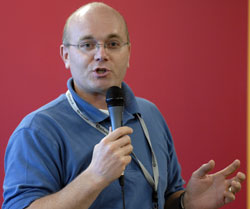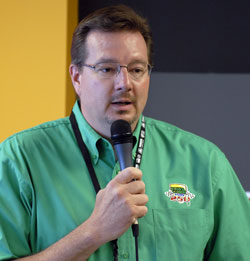 “Policy Risks and Consequences for the Biofuels Industry” will be one of the topics addressed during a Farm Foundation conference entitled “Transition to a Bioeconomy: Risks, Infrastructure and Industry Evolution” June 24-25 in Berkeley, California.
“Policy Risks and Consequences for the Biofuels Industry” will be one of the topics addressed during a Farm Foundation conference entitled “Transition to a Bioeconomy: Risks, Infrastructure and Industry Evolution” June 24-25 in Berkeley, California.
Seth Meyer with the University of Missouri’s Food and Agricultural Policy Research Institute (FAPRI) will talk about some of the findings in a new report that presents 500 different scenarios based on possible weather, production and other market influences.
 Meyer says they found that the two main important factors in any scenario are the price of oil and feedstock production.
Meyer says they found that the two main important factors in any scenario are the price of oil and feedstock production.
“We did this in January and yet we’ve seen oil prices exceed most people’s expectations and that changes the dynamics of which policies are important,” Meyer said. “And then you add to that an unexpected change in (corn) yields and it changes which policies are important yet again.”
Generally speaking, if oil prices are high and production is normal, the Renewable Fuels Standard for corn ethanol is less important. “When we start getting a short crop, those mandates all of the sudden become very binding. It’s a very complicated question,” said Meyer.
When it comes to the blender’s credit, Meyer says that again depends on the situation. “If oil prices would moderate, the mandates would be driving production.”
Listen to an interview with Meyer here:
[audio:http://www.zimmcomm.biz/farm-foundation/seth-meyer-pre.mp3]
Domestic Fuel will provide coverage of the Transition to a Bioeconomy conference that will include an overview of the industry, how biofuels are impacting other segments of the market, and the bioeconomy’s impacts at the farm level. Other sessions will address risks of the bioeconomy; legal, transportation and public policy infrastructure issues; and the challenges and opportunities of the next decade in research, education, business and finance.
 Duke Energy Ohio is seeking proposals for renewable energy resources. The energy company says it’s looking to begin delivering energy through more renewable means sometime between 2009 and 2012. The effort falls in line with Ohio’s new renewable energy portfolio standards.
Duke Energy Ohio is seeking proposals for renewable energy resources. The energy company says it’s looking to begin delivering energy through more renewable means sometime between 2009 and 2012. The effort falls in line with Ohio’s new renewable energy portfolio standards.

 This year’s Iowa Corn Indy 250 is over and as usual, ethanol won. Actually, Dan Wheldon, Target Chip Ganassi Racing won the race.
This year’s Iowa Corn Indy 250 is over and as usual, ethanol won. Actually, Dan Wheldon, Target Chip Ganassi Racing won the race.  The Iowa Corn Indy 250 is underway here at Iowa Speedway and the weather is perfect.
The Iowa Corn Indy 250 is underway here at Iowa Speedway and the weather is perfect.  The qualifying session for the Iowa Corn Indy 250 got rained out last night so unfortunately that means the drivers will start according to their points standing. That was a blow to Team Ethanol. The car was performing very well and would likely have had a much better starting position. Ryan Hunter-Reay, who spoke at the EPIC member reception last night, says he’ll make up for it though.
The qualifying session for the Iowa Corn Indy 250 got rained out last night so unfortunately that means the drivers will start according to their points standing. That was a blow to Team Ethanol. The car was performing very well and would likely have had a much better starting position. Ryan Hunter-Reay, who spoke at the EPIC member reception last night, says he’ll make up for it though. “Policy Risks and Consequences for the Biofuels Industry” will be one of the topics addressed during a Farm Foundation conference entitled
“Policy Risks and Consequences for the Biofuels Industry” will be one of the topics addressed during a Farm Foundation conference entitled  Meyer says they found that the two main important factors in any scenario are the price of oil and feedstock production.
Meyer says they found that the two main important factors in any scenario are the price of oil and feedstock production.  The Ethanol Car wound up practice in the top 10 with a combined (2 sessions) lap speed of 183.114.
The Ethanol Car wound up practice in the top 10 with a combined (2 sessions) lap speed of 183.114. After today’s ethanol press conference the media were treated to rides out on the track in the Iowa Speedway Pace Car.
After today’s ethanol press conference the media were treated to rides out on the track in the Iowa Speedway Pace Car. 
 Just a few minutes ago I got interviewed by one of the journalists here and he asked what I had heard from corn growers who are at the track. I told him they’re very proud to be growing the fuel that’s being used in the IndyCars out here and that they’ll recover from the flooding problems they’ve been having.
Just a few minutes ago I got interviewed by one of the journalists here and he asked what I had heard from corn growers who are at the track. I told him they’re very proud to be growing the fuel that’s being used in the IndyCars out here and that they’ll recover from the flooding problems they’ve been having.  One of the speakers at the ethanol industry press conference here at Iowa Speedway this morning was Mike Sobestski, Vice President/COO,
One of the speakers at the ethanol industry press conference here at Iowa Speedway this morning was Mike Sobestski, Vice President/COO,